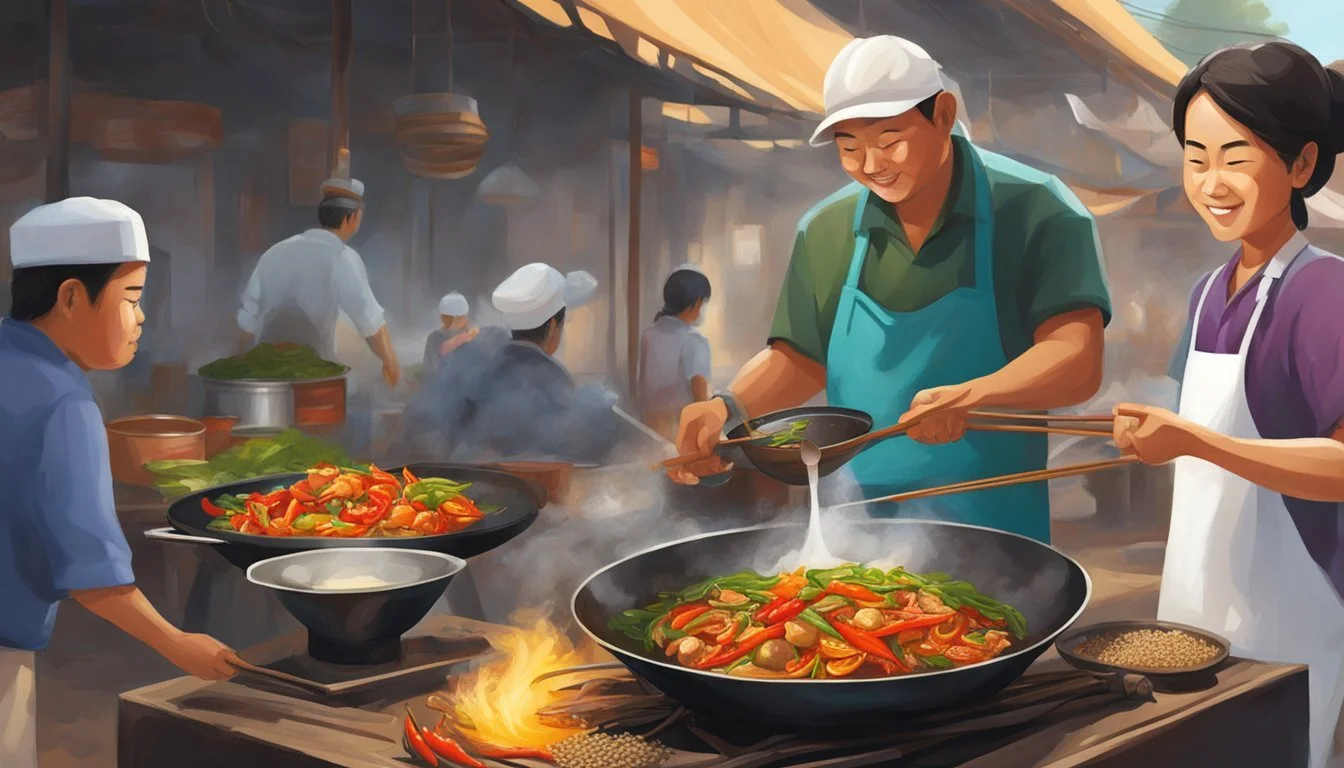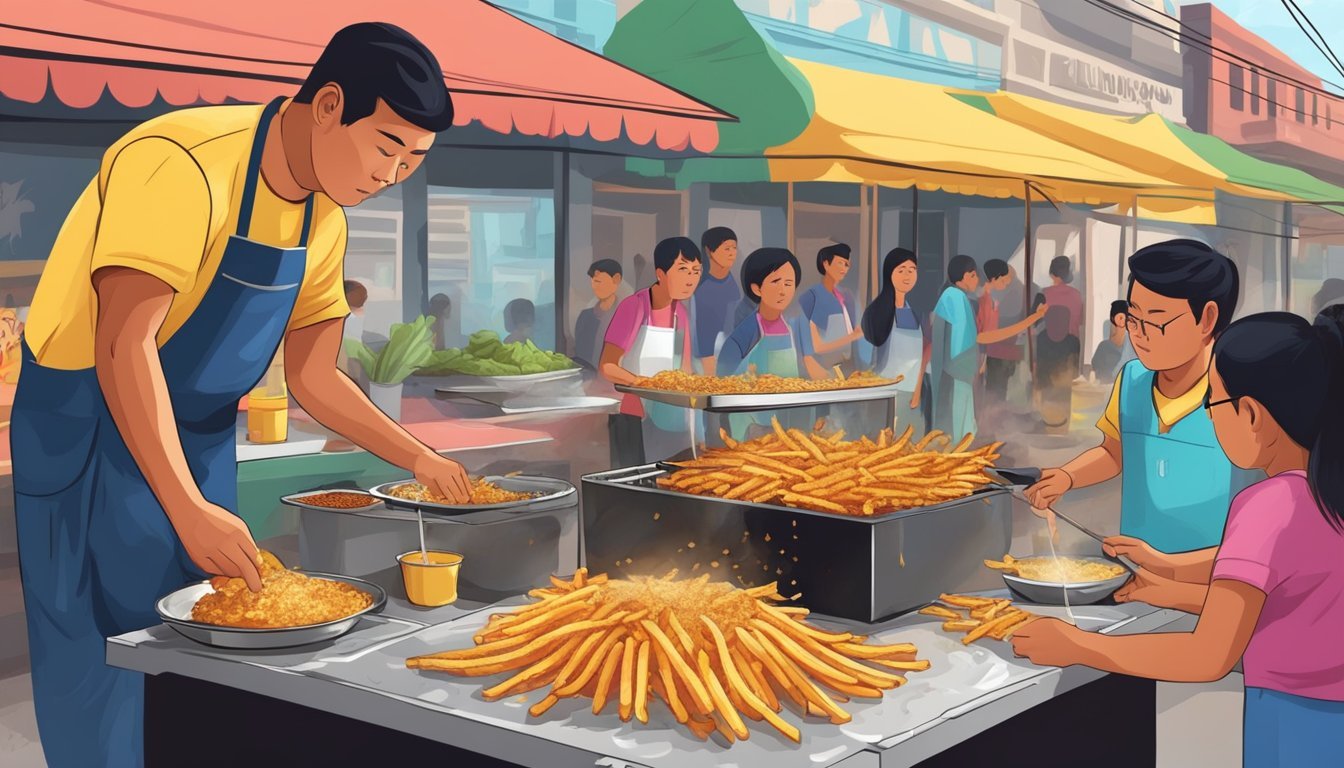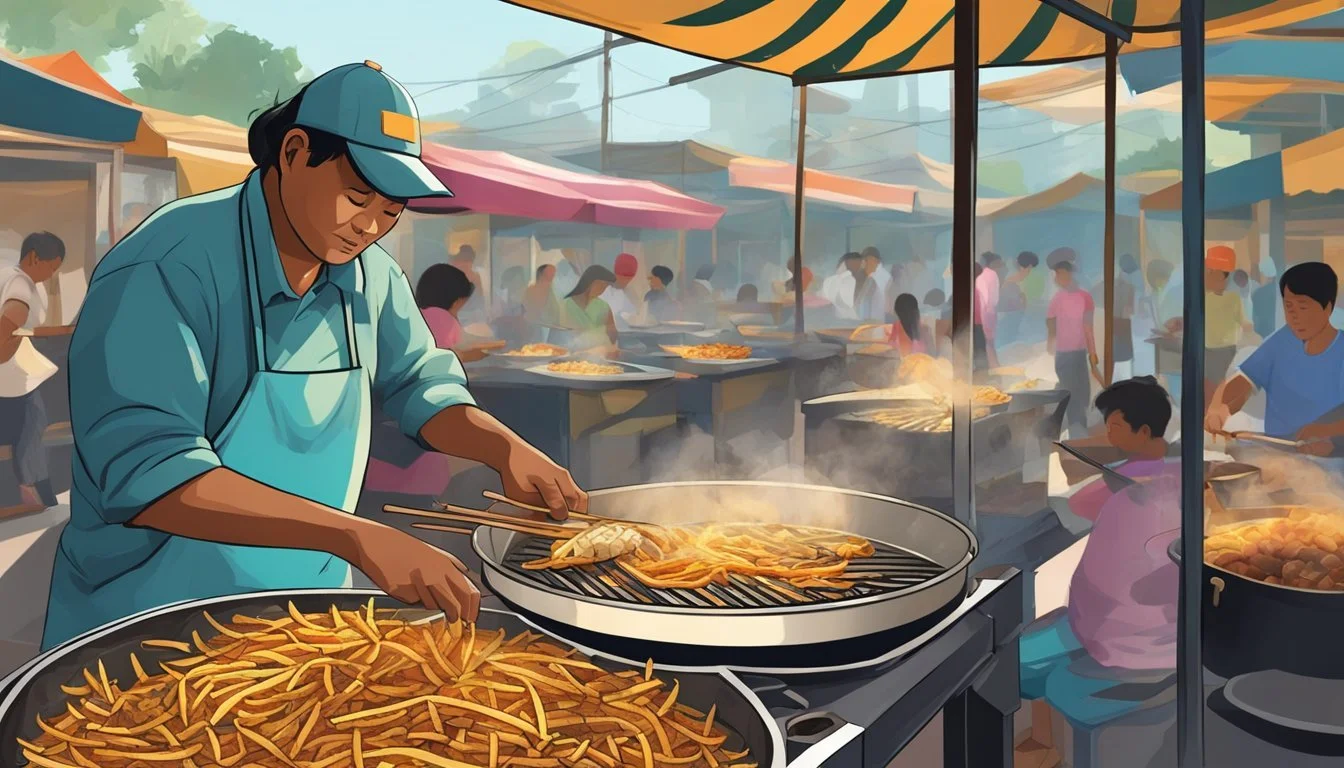Fried Spider
Delving into Cambodia's Unique Culinary Delicacy
In Cambodia, a country renowned for its rich cultural heritage and vibrant cuisine, fried spider has emerged as a peculiar yet popular street food. This unique snack, typically made with zebra tarantulas, is especially associated with the market town of Skuon, though it can be found throughout the country, including in the capital, Phnom Penh. Known locally as 'a-ping', the arachnids are deep-fried until crispy and are often regarded as a must-try experience for adventurous foodies and tourists alike.
The history of consuming these eight-legged creatures is rooted in the country's tumultuous past. It is believed that the practice became widespread during the years of hardship under the Khmer Rouge regime, where food scarcity prompted the local population to turn to alternative food sources. From these times of necessity, fried spiders have transitioned into a sought-after specialty.
Today, vendors can be seen selling the spiders, which are usually cooked with a mix of garlic and sugar to enhance their flavor. These arachnids, bred specifically for consumption, provide a crunchy and peculiar culinary experience that reflects the resilience and inventiveness of Cambodian cuisine. The dish not only offers a taste of local tradition but also represents Cambodia's ability to transform a simple street food item into an internationally recognized delicacy.
Cultural Significance
The fried spider, a curious and unique delicacy has a meaningful place in Cambodian culture, both stemming from historical necessity and evolving into a popular snack that fascinates tourists.
Historical Context
During the mid-to-late 1970s, Cambodia experienced severe food shortages under the Khmer Rouge regime. People were forced to find alternative food sources, and it was out of this necessity that the practice of eating fried spiders began. The spiders, found in the town of Skuon, provided a crucial protein source during a time of starvation and became an emblem of survival.
Modern Day Perception
In modern times, the fried spider is considered a delicacy in Cambodia, particularly in the town of Skuon, also referred to as "Spider Town." The consumption of these fried arachnids has moved past the realm of necessity and into the landscape of tourism and cultural identity. To many Cambodians, they are a common and popular snack, a part of their culinary tradition that highlights their resilience and adaptability. For tourists, sampling this snack is an opportunity to engage with local tradition, albeit an adventurous culinary experience. By the 1990s, it became a celebrated part of Cambodia's street food culture, drawing visitors from around the world eager to partake in this unique aspect of Cambodian culinary heritage.
Preparation and Ingredients
In Cambodia, fried spiders, particularly tarantulas, have become a unique culinary treat. The preparation of this snack involves specific spider selection, meticulous seasoning, and cooking technique, followed by distinctive serving styles that accentuate its flavor.
Spider Selection
The tarantulas used in the popular Cambodian dish are often the Haplopelma Albostriatum species, sought for their size and meatiness. These spiders are either caught in the wild or raised in special burrows to ensure a steady supply for culinary purposes. The abdomen of the spider is particularly prized for its tender texture.
Seasoning and Cooking Method
To prepare the spiders for cooking, they are first cleaned and then seasoned. Common ingredients in the seasoning mix include salt, garlic, and sometimes sugar for a hint of sweetness. Eggs may be used to create a battered exterior. The spiders are then fried in oil until they reach a perfect crispiness. Proper cooking is crucial to bring out the desired crunchy texture without losing the subtle flavors of the meat.
Serving Styles
Upon being fried, these spiders can be served in various ways. Some choose to roll them in additional sugar or garlic post-frying to enhance the taste. They are often accompanied by a sauce for dipping, which could range from a simple mixture of salt and pepper to a more complex, seasoned sauce. Fried spiders can be eaten as a snack on their own or as part of a larger meal.
Nutritional and Health Considerations
Fried spider, a crispy street food specialty from Cambodia, offers a unique combination of texture and nutrition. The consumption of these arachnids can provide protein while also presenting an exotic eating experience with its crunchy exterior and soft centre.
Edible Parts
When it comes to eating fried spiders, particularly the species often found in Cambodian cuisine, the entire spider is typically consumed, except for the fangs.
Abdomen: The abdomen may contain a soft centre which can include the spider's organs.
Excrement: Prior to cooking, the abdomen is generally cleaned to remove any excrement, ensuring that the edible parts are hygienic.
Potential Health Benefits
Fried spiders are not only a novel culinary experience but also add nutritional value to the diet.
Protein: They are a rich source of protein, essential for muscle repair and growth.
Nutrients: Depending on the exact species and preparation, they may also contain vitamins, minerals, and healthy fats.
| Nutrient | Potential Content in Fried Spiders |
|----------------|--------------------------------------|
| Protein | High |
| Fat | Varied, may contain healthy fats |
| Carbohydrates | Low to none |
| Vitamins | Can be a source of B vitamins |
| Minerals | May include iron, zinc, and potassium|Consumption of spiders has been prevalent during periods of food scarcity, and their inclusion in the diet has offered sustenance and nutritional benefits in these times. However, it's important to note that while fried spiders may be a protein-rich snack, they should be considered part of a balanced diet.
Regional Variations
Fried spiders have become a notable feature in Cambodia's diverse culinary landscape, particularly recognized as a traditional street food specialty that varies in its presence and preparation across the country.
Availability Across Cambodia
Fried spiders, known locally as a-ping, are predominantly found in the town of Skun in Cheung Prey, Kampong Cham. They have gained prominence as a unique snack that attracts both tourists and locals. One can find them being sold by vendors who often display them in large quantities. In Phnom Penh, Cambodia's bustling capital, these crunchy delicacies are less common but can still be found, offering a taste of the adventurous traditional Cambodian cuisine to those eager to explore beyond the typical Khmer food offerings.
International Comparisons
The concept of eating insects is not singular to Cambodian cuisine. For instance, in Mexico, tacos filled with chapulines (grasshoppers) are a traditional food enjoyed by many. Similarly, Vietnam has its share of exotic treats, such as snake-based dishes that challenge the culinary norms of Western cultures. Fried spiders in Cambodia can be likened to these examples, as each represents a region-specific staple that reflects cultural history and the practical use of available resources. However, unlike guacamole in Mexico, which has gained international acceptance as a beloved condiment, the peculiarity of fried spiders remains a distinct feature exclusive to Cambodian food culture.
Economic Impact
The bustling markets of Skuon, known colloquially as "Spiderville," illustrate the significant role that fried tarantulas play in Cambodia's informal economy. This delicacy bolsters both local and national economies through vibrant market trade and increased tourism.
Market and Vendor Dynamics
The markets of Cheung Prey district, particularly in Skuon, act as central hubs for the sale of fried spiders, a Cambodian street food specialty. The vendors, who are typically locals, partake in a complex economy, ranging from spider catchers to sellers. Prices per spider can vary, reflecting factors such as size and seasonality. The establishment of a standardized market for this unique snack provides a stable income for those involved in this niche trade. Data on the exact financial figures is scarce, but the spider business is known to be a source of livelihood for many families in the region.
Tourism and Local Business
Fried spiders have not only intrigued locals but have also captured the attention of adventurous tourists, further integrating this snack into the Cambodian street food scene. To cater to the interest of international visitors, local businesses often sell fried spiders alongside other traditional snacks, creating a diverse culinary experience for tourists. This, in turn, leads to increased spending at local businesses. The snacks serve as an entry point for tourists into a broader exploration of Cambodian culture and cuisine, supporting a variety of businesses, from street food vendors to local restaurants and market stalls.
Legal and Ethical Considerations
When indulging in the traditional Cambodian delicacy of fried spiders, one must consider the sustainability of the spider population and the legal frameworks surrounding wildlife consumption. These issues are critical not only for preserving Cambodia's culinary heritage but also for ensuring the ecological balance and compliance with local and international laws.
Sustainability of Harvesting
The harvesting of spiders for human consumption raises questions of sustainability. Tarantulas, like any wildlife species, require careful management to prevent overharvesting. Conservation efforts are essential to ensure that these spiders do not become endangered due to their popularity as a snack. Communities and authorities must collaborate to monitor and regulate the collection of spiders, ensuring that the practice does not disrupt local ecosystems or lead to a decline in spider populations. Maintaining a balance is crucial for the health of the forests where these spiders are found.
Regulations on Wildlife Consumption
The consumption of wildlife in Cambodia, including spiders, is subject to the country's Traditional Food Law. This law is designed to safeguard the health of consumers and protect species from overexploitation. Regulations define what can be legally consumed and outline guidelines to ensure that wildlife is harvested and sold in a humane and ethical manner. Moreover, international laws may influence Cambodia's domestic policies on wildlife consumption, with organizations advocating for the protection of species that might be affected by international trade or perceived as exotic foods. It is important for vendors and consumers alike to abide by the law to avoid penalties and support the ethical treatment of wildlife used for human consumption.
Societal Perceptions
In Cambodian society, the consumption of fried spiders reflects a complex interplay of history, necessity, and evolving tastes that encompasses both local traditions and tourist curiosity.
Between Necessity and Snack
History: Fried spiders emerged out of necessity during the ruling years of the Khmer Rouge. The Cambodian people faced food shortages, and spiders became a critical source of nutrition. Today's Context: What was once a vital food source during a troubled period has transitioned into a popular snack, savored for its unique taste and crunchiness.
Local versus Tourist Perspectives
Locals: For many Cambodians, fried spiders are a part of their culinary tradition, although not all partake in eating them. Tourists: Visitors often see trying this snack as an adventure, an opportunity to engage with Khmer cuisine and to take part in an authentic local experience.
Cuisine as Cultural Identity
Cuisine Reflecting Identity: The local delicacy of fried spiders is more than just food; it's an expression of cultural identity for Cambodians. It's intertwined with the country's history and symbolizes the resilience and adaptability of the Cambodian people. Threatened Species Consideration: While it is a traditional part of Khmer cuisine, there is an ongoing conversation about the conservation of species and sustainable practices, ensuring that this cultural hallmark does not contribute to the decline of local spider populations.






